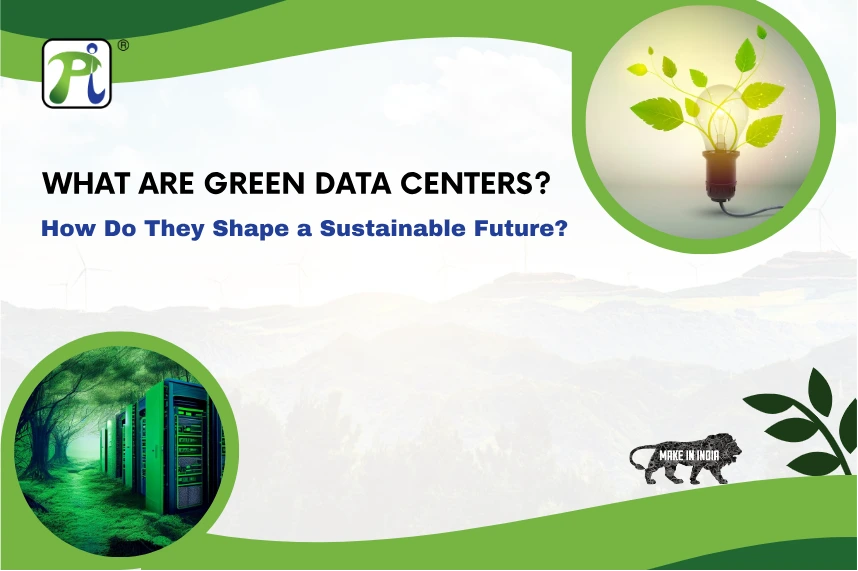We Will Get Back To You As Soon As Possible


Green data centers are facilities designed to minimize environmental impact through energy-efficient practices and technologies. They represent a pivotal stride towards minimizing the ecological footprint of digital infrastructure. In an era where the digital sector accounts for a substantial portion of global carbon emissions—ranging from 1.5 to 4 percent—the imperative to adopt sustainable practices in data centers becomes increasingly urgent. Not only do data centers consume significant amounts of energy, but they also impose strains on water and land resources, exacerbating environmental pressures.
Acknowledging this challenge, the International Energy Agency (IEA) highlights that data centers contribute to 1 to 1.5 percent of global electricity consumption. However, the advent of green data centers offers a promising avenue for mitigating this impact. By leveraging energy-efficient technologies like server virtualization, enhanced cooling systems, and optimized power distribution, these centers strive to curtail energy consumption substantially. Moreover, by embracing renewable energy sources such as wind, solar, hydro, and geothermal power, they further alleviate their environmental footprint.
The significance of green data centers extends beyond mere operational efficiency. They serve as key components in sustainable digital transformation, facilitating endeavors to combat climate change. By reducing emissions and fostering resource conservation, green data centers align with global sustainability objectives. Notably, the burgeoning green data center market underscores the increasing recognition of their pivotal role. Valued at $88 billion in 2023, this market is projected to burgeon to $423.7 billion by 2032, indicative of the growing traction towards sustainability.
Governments wield considerable influence in shaping the landscape for green data centers through policy frameworks and incentives. Initiatives such as establishing green building standards, incentivizing renewable energy adoption, regulating refrigerant usage, and promoting efficient e-waste management are instrumental in fostering an enabling environment. By providing regulatory clarity and financial incentives, governments catalyze the transition towards sustainable data infrastructure.
For enterprises, embracing green data centers entails multifaceted benefits. Beyond reducing carbon footprints and trimming energy expenses, it enhances corporate reputation and appeals to environmentally conscious stakeholders. By aligning with sustainable practices, companies bolster their image, attract ethically minded consumers and investors, and advance towards carbon neutrality—a paramount objective in today's climate-conscious landscape.
Green data centers stand as pillars of sustainability, offering a plethora of advantages that reverberate across economic, environmental, and social spheres. These benefits encapsulate:
By curbing energy consumption, green data centers translate into substantial reductions in operational costs and electricity expenditures over time, fortifying financial sustainability.
Leveraging innovative design and technology, green data centers optimize space utilization, minimizing real estate requirements and associated costs while maximizing efficiency.
Through the adoption of innovative cooling methodologies, green data centers mitigate water usage, exemplifying responsible resource stewardship and contributing to water conservation efforts.
With a diminished reliance on fossil fuels and energy-efficient practices, green data centers tangibly reduce carbon emissions, bolstering environmental sustainability and climate change mitigation endeavors.
By integrating redundancy mechanisms and advanced cooling systems, green data centers enhance operational reliability, ensuring uninterrupted service delivery and bolstering business continuity.
Embracing green data centers burnishes a company's image, resonating positively with environmentally conscious stakeholders, thereby bolstering brand reputation and fostering consumer and investor trust.
Providing healthier work environments, green data centers promote employee well-being, fostering higher levels of job satisfaction, productivity, and retention.
Green data centers cultivate positive relationships with local communities by demonstrating a commitment to environmental responsibility, thus fostering goodwill and collaboration.
Many governments incentivize the adoption of green data centers through tax breaks and financial support, further encouraging sustainable business practices.
Green data centers confer a competitive advantage in the marketplace, resonating strongly with consumers and businesses alike who prioritize environmental stewardship, thereby positioning organizations as leaders in sustainable computing.
These multifaceted benefits underscore the pivotal role of green data centers in forging a sustainable digital economy and combating climate change. By investing in green data centers, organizations not only mitigate their environmental impact and realize cost savings but also position themselves as trailblazers in sustainable business practices, fostering a brighter and more resilient future for all.
Despite the undeniable benefits of green data centers, their construction presents a unique set of challenges. However, through innovative strategies and technologies, these challenges can be effectively addressed:

The upfront investment required for implementing energy-efficient technologies and renewable energy sources often poses a significant barrier. Mitigating this challenge involves conducting thorough cost-benefit analyses to showcase the substantial long-term savings accrued from reduced energy consumption and operational costs. Additionally, exploring financing options and incentives can help alleviate initial financial burdens.
Traditional cooling methods in data centers, such as air conditioning, are notorious for their high energy consumption. Transitioning to more efficient cooling solutions like liquid cooling systems or harnessing natural cooling methods, such as fresh air cooling, can markedly reduce energy usage and associated costs. Employing advanced thermal management technologies also aids in optimizing cooling efficiency.
Central to the ethos of green data centers is the imperative to minimize carbon emissions. Embracing renewable energy sources like solar, wind, or geothermal power holds the key to achieving carbon neutrality or even negative emissions. Moreover, integrating energy-efficient design principles and employing carbon offsetting strategies contribute to mitigating the environmental impact of data center operations.
As custodians of sensitive data, ensuring robust security measures within green data centers is paramount. Implementing comprehensive information security protocols, conducting regular risk assessments, and fortifying physical access controls help fortify defenses against potential breaches. Collaborating with cybersecurity experts and adhering to industry best practices further bolsters the resilience of data center infrastructure.
Sustainable waste management practices are integral to the ethos of green data centers. Adopting circular economy principles, such as recycling and reusing materials, minimizes waste generation and promotes resource conservation. Innovative cooling systems that incorporate water recycling mechanisms and prioritize e-waste reduction play a pivotal role in fostering sustainability throughout the data center lifecycle.
By proactively addressing these challenges through strategic planning, technological innovation, and collaborative partnerships, the realization of green data centers as pillars of sustainable computing becomes increasingly attainable. Despite the complexities involved, the imperative to overcome these obstacles is outweighed by the transformative potential of green data centers in shaping a more resilient and environmentally conscious digital infrastructure landscape.
To surmount the challenges inherent in constructing green data centers, organizations can employ a range of strategic approaches, including:
Conducting comprehensive cost-benefit analyses is paramount to demonstrating the long-term financial viability of green data center initiatives. By quantifying the potential savings from reduced energy consumption and operational costs over the facility's lifecycle, stakeholders can make informed investment decisions and garner support for sustainable initiatives.
Embracing cutting-edge energy-efficient technologies, such as liquid cooling systems and renewable energy sources, forms the cornerstone of green data center construction. These innovations not only minimize energy consumption and associated costs but also contribute to environmental sustainability by reducing carbon emissions and resource depletion.
Addressing security concerns necessitates the implementation of robust information security programs and regular risk assessments. By deploying advanced cybersecurity protocols and restricting physical access to sensitive areas, organizations can safeguard data integrity and bolster trust among stakeholders.
Prioritizing waste reduction strategies, including recycling and material reuse, underscores a commitment to environmental responsibility. By adopting circular economy principles throughout the data center lifecycle, organizations can minimize waste generation, conserve resources, and mitigate their environmental footprint.
By proactively integrating these strategies into their construction and operational practices, organizations can successfully navigate the challenges associated with building green data centers. Beyond mere environmental stewardship, these efforts yield tangible benefits such as cost-effectiveness, enhanced security, and resilience, thereby contributing to a more sustainable and prosperous future.
In conclusion, the emergence of green data centers represents a pivotal shift towards sustainability in the digital era. While the construction and operation of these facilities pose formidable challenges, proactive strategies and innovative technologies offer viable solutions to overcome them.
By conducting thorough cost-benefit analyses, organizations can demonstrate the long-term financial viability of green data center initiatives, garnering support and investment. Embracing energy-efficient technologies and renewable energy sources not only reduces operational costs but also mitigates environmental impact, paving the way for carbon neutrality and resource conservation. The pursuit of green data centers signifies more than just technological advancement; it symbolizes a collective commitment to fostering a sustainable future.
Questions? We're here to help.
©2025 Pi DATACENTERS® Pvt. Ltd. All rights reserved
